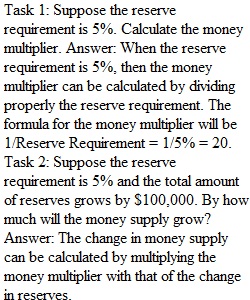


Q MONETARY POLICY IN-CLASS WORKSHEET 1 This question explores the role of expansionary and contractionary monetary policy in the aggregate demand and aggregate supply model. You will use schedules for an aggregate demand line and an aggregate supply line to identify the equilibrium price level and real GDP in a macroeconomy. Additionally, you will compare the short-run equilibrium level of real GDP to the full employment level of real GDP to identify desirable monetary policies. Below, you are provided the schedules for aggregate demand and supply lines Price Level (Consumer Price Index) Aggregate Demand Real GDP (billions of dollars) Aggregate Supply Real GDP (billions of dollars) 80 $11 $ 8 90 $10 $10 100 $ 9 $12 110 $ 8 $14 120 $ 7 $16 Task 1: Identify the macroeconomic equilibrium price level in this economy. Task 2: Identify the macroeconomic equilibrium level of real GDP in this economy. Task 3: If the full employment level of real GDP is $9 billion, can you discern whether this economy is experiencing an inflationary gap or a recessionary gap? Task 4: Suppose that the Federal Reserve wants to promote full employment. Should it enact contractionary or expansionary monetary policy? Task 5: Suppose that the Federal Reserve wants to promote full employment through the money supply. Should it increase or decrease the amount of bank reserves? Explain your answer carefully. Task 6: Suppose that the Federal Reserve wants to promote full employment through the reserve requirement. Should it increase or decrease the reserve requirement? Explain your answer carefully. MONETARY POLICY IN-CLASS WORKSHEET 2 This question explores the role of expansionary and contractionary monetary policy in the aggregate demand and aggregate supply model. You will use schedules for an aggregate demand line and an aggregate supply line to identify the equilibrium price level and real GDP in a macroeconomy. Additionally, you will compare the short-run equilibrium level of real GDP to the full employment level of real GDP to identify desirable monetary policies. Below, you are provided the schedules for aggregate demand and supply lines. Price Level (Consumer Price Index) Aggregate Demand Real GDP (billions of dollars) Aggregate Supply Real GDP (billions of dollars) 80 $12 $ 4 90 $10 $16 100 $ 8 $ 8 110 $ 6 $10 120 $ 4 $12 Task 1: Identify the macroeconomic equilibrium price level in this economy. Task 2: Identify the macroeconomic equilibrium level of real GDP in this economy. Task 3: If the full employment level of real GDP is $9 billion, can you discern whether this economy is experiencing an inflationary gap or a recessionary gap? Task 4: Suppose that the Federal Reserve wants to promote full employment. Should it enact contractionary or expansionary monetary policy? Task 5: Suppose that the Federal Reserve wants to promote full employment through the money supply. Should it increase or decrease the amount of bank reserves? Explain your answer carefully. Task 6: Suppose that the Federal Reserve wants to promote full employment through the reserve requirement. Should it increase or decrease the reserve requirement? Explain your answer carefully.
View Related Questions